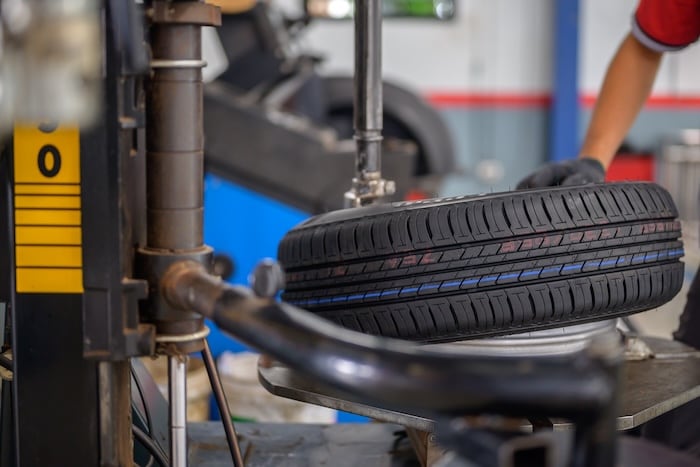
Your tires are the foundation of your vehicle’s safety and performance. Yet, they’re often one of the most overlooked aspects of car maintenance. Driving on worn or damaged tires can put you and others at risk, not to mention it can cost you more in the long run.
How do you know when it's time for tire service? This guide will highlight the key warning signs to watch for and help you determine when to schedule a professional inspection.
1. Tread Depth is Too Low
Your tire tread is crucial for maintaining grip on the road, particularly in wet or slippery conditions. Over time, the tread naturally wears down, which reduces your tires’ ability to disperse water and maintain traction.
How can you check tread depth?
- Perform the penny test. Insert a penny into the tire tread with Lincoln’s head facing down. If you can see all of his head, your tread is less than 2/32 of an inch deep, and it’s time to replace your tires.
- Alternatively, look for the wear bars on your tire. These are small, raised sections running across the grooves of the tread. If they’re level with the surrounding tread, your tires need attention immediately.
Driving on balding tires increases your risk of hydroplaning and reduces overall vehicle control, especially during inclement weather. Don’t wait—low tread depth is a clear sign you need tire service.
2. Steering Wheel Vibrations
Have you noticed your steering wheel shaking or vibrating as you drive? While this could point to other mechanical issues, such as unbalanced or misaligned wheels, it’s a red flag for tire problems.
Vibrations often occur when:
- A tire is out of balance.
- A tire has suffered internal damage, such as a separated or warped belt.
- You have uneven tread wear from poor alignment or suspension issues.
Ignoring these vibrations can affect your driving comfort and lead to uneven tire wear, creating an even bigger problem down the road.
3. Tires are Losing Pressure Quickly
Regularly checking your tire pressure is an essential part of car ownership. But what if you’re finding yourself refilling the air more often than usual?
Consistently low tire pressure could indicate issues such as:
- A slow leak, possibly from a nail or screw embedded in the tire.
- A damaged valve stem.
- A weakened tire bead that no longer forms a perfect seal on the wheel.
Driving with underinflated tires doesn’t just cost you more on gas—due to increased rolling resistance—but it also causes premature wear and tear. If your tires are losing pressure quickly, it’s time to book an inspection.
4. Your Tires are Noisy
A certain amount of road noise is normal while driving, but excessively loud or unusual sounds coming from your tires shouldn’t be ignored.
Common causes of tire noise include:
- Uneven wear due to improper alignment or missed rotations.
- Feathering, where the tread ribs develop a saw-tooth pattern.
- An internal tire issue, such as a shifted or damaged belt.
If you find your tires howling, squealing, or thumping unusually while on the road, it’s not just an annoyance—it’s a sign of a potential problem that needs addressing.
5. Poor Traction
Do you feel like your car is slipping and sliding more frequently? Poor traction isn’t just inconvenient—it’s incredibly dangerous, especially in wet, icy, or sandy conditions.
Signs of traction problems include:
- Increased stopping distance.
- Trouble accelerating without slipping, especially in rainy or snowy weather.
- Loss of grip during sharp turns or lane changes.
Traction issues arise most often due to worn-out tread. Without sufficient tread depth, your tires can’t effectively grip the road or channel water away, leading to skidding and hydroplaning.
6. Cracks, Bulges, or Dry Rot
Visible damage is one of the most obvious signs your tires need service. Over time, tires naturally degrade due to exposure to fluctuating temperatures, UV rays, and plain old wear and tear.
Watch for the following signs:
- Sidewall Cracks: Tiny surface cracks in the tire’s rubber can indicate aging or dry rot. While minor cracking might not require immediate replacement, deep cracks do.
- Bulges or blisters in the tire wall. These are often caused by internal structural damage, such as broken cords or air pockets, and put your tire at high risk of a blowout.
- Flat spots, especially if your vehicle was parked for extended periods, which can compromise safety.
If you notice visible damage, don’t risk driving on compromised tires. Immediate inspection and replacement may be necessary.
Stay Safe—Schedule Tire Service at Stokes Chevrolet
From ensuring proper traction to protecting against blowouts, keeping your tires in top shape is one of the simplest yet most effective ways to maintain your car’s safety and performance.
If you’ve noticed any of the signs mentioned above—or it’s been a while since your last inspection—don’t wait. The expert team at Stokes Chevrolet in Moncks Corner, SC, is ready to help. Our technicians provide professional tire services, from rotations and pressure checks to alignments and replacements, to get you back on the road with confidence.
Schedule your tire service in Moncks Corner, SC, and drive knowing your car is in the best condition possible.